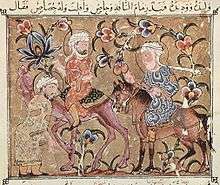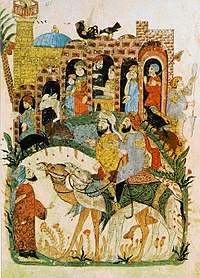Al-Hariri of Basra
| Al-Hariri الحریری البصری | |
|---|---|
| Born |
Abū Muhammad al-Qāsim ibn Alī ibn Muhammad ibn Uthmān al-Harīrī أبو محمد القاسم بن علي بن محمد بن عثمان الحريري 1054 Al-Mashan Village, near Basra, Abbasid Caliphate, now Basra Governorate, Iraq |
| Died |
9 September 1122 (aged 68) Basra, Abbasid Caliphate, now Basra Governorate, Iraq |
| Occupation | Arab Poet, Writer, Scholar of Arabic language, Official of Seljuk Empire |
| Notable works | Maqamat al-Hariri مقامات الحريري |
Abū Muhammad al-Qāsim ibn Alī ibn Muhammad ibn Uthmān al-Harīrī (Arabic: أبو محمد القاسم بن علي بن محمد بن عثمان الحريري), popularly known as al-Hariri of Basra (1054– 9 September 1122) was an Arab poet, scholar of the Arabic language and a high government official of the Seljuk Empire.[1]
He is known for his Maqamat al-Hariri, a collection of some 50 stories.
Biography
Born in Basra in modern-day Iraq into a wealthy family, he studied jurisprudence and became a government official, but is best known for writing Maqamat al-Hariri (مقامات الحريري, The Assemblies of al-Hariri), a virtuosic display of saj', consisting of 50 anecdotes written in stylized prose, which was once memorized by heart by scholars, and Mulhat al-i'rab fi al-nawh, an extensive poem on grammar.[2] The most famous translation of his maqamat was a German version by the poet and Orientalist Friedrich Rückert as Die Verwandlungen von Abu Serug and sought to emulate the rhymes and wordplay of the original.[3][4] The main English translation is the nineteenth-century one by Thomas Chenery and Francis Joseph Steingass.[5]

Some of his other works include a book on errors of expression in Arabic, Durrat al-ghawwāṣ fī awhām al-khawaṣṣ. The Assemblies of al-Hariri recounts in the words of the narrator, al-Harith ibn Hammam and al-Hariri's several encounters with artist Abu Zayd al-Saruji.[2]
Editions and translations
- Charles F. Horne, ed., The Sacred Books and Early Literature of the East, (New York: Parke, Austin, & Lipscomb, 1917), Vol. VI: Medieval Arabia, pp. 143–201, http://legacy.fordham.edu/halsall/basis/1100Hariri.asp (contains maqāmāt 1-12)
 "Discussion Near a Village", a miniature illustrating the 43rd maqāmah of a 1237 edition of al-Hariri's Maqamat al-Hariri, painted by Yaḥyā ibn Maḥmūd al-Wāsiṭī. Painting in the Bibliothèque Nationale, Paris. MS Arabe 5847 fol. 138v.
"Discussion Near a Village", a miniature illustrating the 43rd maqāmah of a 1237 edition of al-Hariri's Maqamat al-Hariri, painted by Yaḥyā ibn Maḥmūd al-Wāsiṭī. Painting in the Bibliothèque Nationale, Paris. MS Arabe 5847 fol. 138v. - Shah, Amina (trans.), The Assemblies of Al-Hariri: Fifty Encounters with the Shaykh Abu Zayd of Serju (London: Octagon, 1980)
- Preston, Theodore (trans.), Makamat or Rhetorical Anecdotes of Al Hariri of Basra, Translated from the Original Arabic with Annotations (Cambridge: Cambridge University Press, 1850)
| Wikimedia Commons has media related to Category:Maqamat of al-Hariri - BNF Arabe5847. |
See also
External links
| Arabic Wikisource has original text related to this article: |
| Wikisource has the text of a 1911 Encyclopædia Britannica article about Al-Hariri. |
- Maqamat Al-Hariri page
- Maqamat page
- Works by or about Al-Hariri of Basra at Internet Archive
- Works by Al-Hariri of Basra at LibriVox (public domain audiobooks)

References
- ↑ Assemblies of Al-Hariri Archived 2008-07-06 at the Wayback Machine. Shah, Amina. Octagon Press, 78 York Street London
- 1 2 al-Hariri Encyclopædia Britannica 2008. Encyclopædia Britannica Online. .2008-03-12
- ↑ Die Verwandlungen von Abu Serug. Books.google.com. Retrieved 2012-02-04.
- ↑ See: Luisa Arvide, Maqamas de Al-Hariri, GEU, Granada 2009 (in Arabic and Spanish).
- ↑ The Assemblies of Al-Ḥarîri. Translated from the Arabic with Notes Historical and Grammatical, trans. by Thomas Chenery and F. Steingass, Oriental Translation Fund, New Series, 3, 2 vols (London: Royal Asiatic Society, 1867-98), https://archive.org/details/assembliesofalha015555mbp (vol. 2).